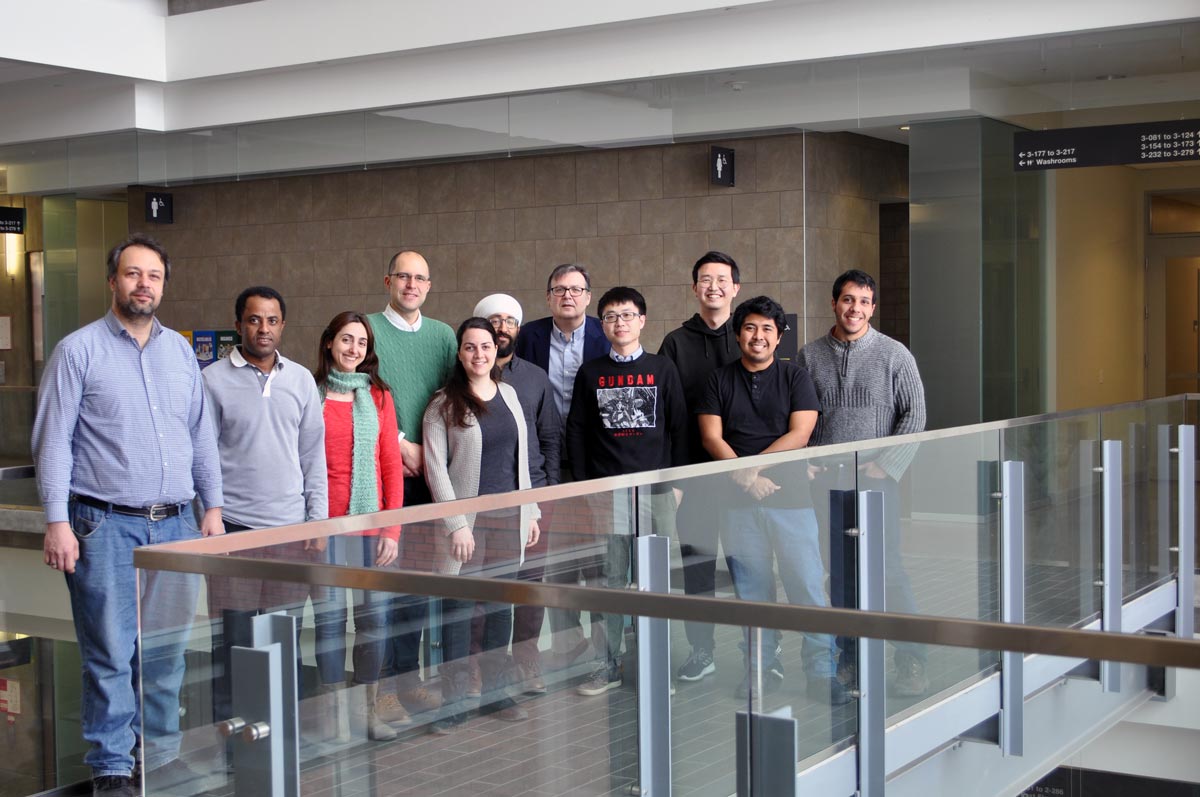
Professor and chair of the Department of Physics, Mauricio Sacchi (fifth from the right), is well known for his passionate encouragement of students and colleagues.
Chances are if you've studied physics at the University of Alberta in the last twenty years, the name Mauricio Sacchi is a familiar one. This beloved professor and chair of the Department of Physics is well known for his passionate encouragement of students and colleagues. An advocate for focusing on science as a solution for some of society's most pressing challenging, Sacchi is committed to the active exploration of synergy between academia and industry. And that fierce dedication to working together develop the next generation of geophysicists is being formally recognized by the Canadian Society of Exploration Geophysicists. Sacchi is being honoured as the 2018 CSEG Symposium Honouree for his long standing commitment to building bridges between academia and industry. We recently spoke about what the recognition means to him and what it is that fuels his ongoing fire for exploration seismology. /p>
What got you hooked on geophysics?
When I completed high school, I was interested in math and physics. The University of La Plata was printing a guide for students with career options. This was the pre-internet era. Geophysics caught my attention because the program had math and physics, and it was offering courses where one could relate mathematics and physics to real-world practical problems. Geophysics was also a career with options outside the academic environment which was a plus when I was starting my BSc.
What keeps you interested and excited year after year?
I have always been interested in the solution of inverse problems or, in other words, on numerical tools that can turn measurements taken on the surface of the earth on "unseen" properties inside the earth. When we teach mathematics and physics to undergraduates, we often focus on solving analytical or numerical problems that one could call "direct problems," for instance, knowing the density distribution of Earth, how do we compute its gravity field? In the inverse problem, we turn the question around. Given the gravity field--something we can measure--what is the density distribution of Earth--something we cannot measure. Problems that are everywhere in the theory of "inverse problems," such as non-uniqueness and stability of solutions, are of significance for geophysicists because they could have a considerable impact on, for instance, subsurface exploration of oil and gas. Working with graduate students in these types of problems keeps me going.What does it mean to you to be honoured by your peers in such an important way?
I feel fortunate that people have paid attention to the work carried out by students in my lab. The type of research carried out by my group is applied and therefore, it needs to grow outside of the academy. Being honoured by a professional society means that we are on the right track.
The theme for this year's symposium is challenges and opportunities that the exploration seismology profession faces. In your opinion, what are the biggest challenges and opportunities for geophysics?
Speaking about my area of geophysics--exploration seismology, geophysical datasets are becoming huge. This is particularly true for the type of datasets that are used by exploration seismologists. Being able to process and invert these datasets is one significant challenge. The other challenge is the development of fast and low-cost strategies for acquiring seismic data. Considerable progress in random sampling theory and signal recovery techniques is making an impact in the field of data acquisition, and the area is generating interesting opportunities for graduate students.
What are your hopes and goals for the future of the field?
The University of Alberta has a long tradition of high-calibre research and interaction with industry in applied geophysics. With effort, we have been able to grow and maintain a large and healthy graduate program. Today, many of the students graduating from our program occupy key R&D positions in large oil companies and contractors worldwide. I hope to continue to contribute to maintaining the prestige that our program enjoys globally.
Why are academia/industry collaborations so important?
I believe they are essential for people working in an applied field like mine. We all know that only a small number of graduate students will continue on an academic/professorial career. Working with industry offers graduate students interaction with potential future employees. In my field, also, most exciting developments in the past have happened via synergy between university and industry, and therefore, it is natural to establish links with industry.
Why is it important to bring scientists, industry, and students together at forums such as the CSEG symposium?
Like in other geophysical conferences, people need to meet to hear problems often posed by industry. These meetings provide an excellent opportunity for students to see where our field is moving and to prepare for changes that might happen in the future.